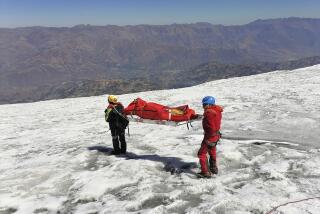As a glacier melts, so does a Peruvian water supply
- Share via
The Qori Kalis glacier in the Andes of southwest Peru is retreating by about 600 feet a year. Its icy blue headwall is melting away.
As the ice disappears, so does the water supply for hundreds of thousands of people in the valley below.
Cuzco, the closest big city, is already starting to ration water.
“You can almost sit there and watch it retreat,” says Lonnie Thompson, a 58-year-old Ohio State University geologist whose research first brought him to the glacier in the late 1970s. He has returned about 20 times.
“It’s kind of like watching your buddy die,” Thompson said.
The glacier, part of the world’s largest tropical ice cap, has not been this small for at least 5,000 years, based on analysis of dead plants that have been left by the retreating glacier.
Eventually, dams will be needed to store water in the rainy season and release it in the dry season, Thompson said.
“Of course, Peru is not a rich country,” he said.
Beneath the glacier’s headwall, meltwater has formed a 200-foot-deep lake. Below that is an expansive plain, normally a grassland dotted with alpacas.
On Thompson’s most recent return last spring, the plain was coated with silt.
An avalanche of rock and ice, unleashed by warming, had landed in the lake and set off a flood through the valley.
The animals were gone.
-- Alan Zarembo
More to Read
Sign up for Essential California
The most important California stories and recommendations in your inbox every morning.
You may occasionally receive promotional content from the Los Angeles Times.











